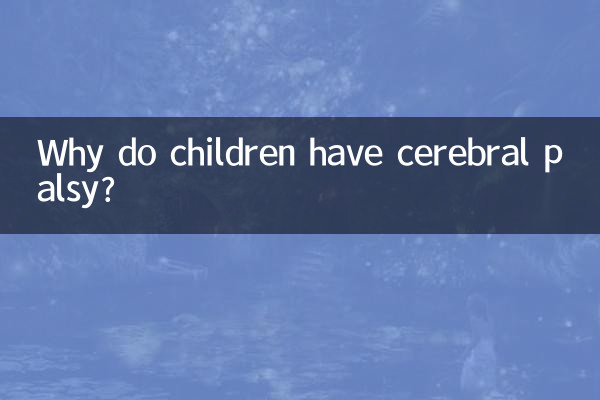Why do children have cerebral palsy?
Cerebral Palsy (CP) is a common movement disorder in children, mainly characterized by difficulty in muscle control, abnormal posture and movement coordination disorders. In recent years, the incidence of cerebral palsy has been on the rise globally, arousing widespread concern. This article will combine the hot topics and hot content on the Internet in the past 10 days to conduct a structured analysis of the causes of cerebral palsy in children from the aspects of causes, risk factors, preventive measures, etc.
1. Main causes of cerebral palsy

The causes of cerebral palsy are complex and varied, often related to brain damage during fetal life, during childbirth, or after birth. The following is a classification of common causes:
| Cause type | specific reasons | Proportion (reference data) |
|---|---|---|
| prenatal factors | Abnormal fetal development, intrauterine infection, genetic factors | about 40% |
| intrapartum factors | Hypoxic asphyxia, premature birth, dystocia | about 50% |
| postpartum factors | Neonatal jaundice, brain trauma, meningitis | about 10% |
2. High risk factors for cerebral palsy
According to recent medical research and hot discussions, the following factors may increase the risk of cerebral palsy in children:
| risk factors | illustrate |
|---|---|
| premature birth | Less than 37 weeks of pregnancy, especially very low birth weight babies (<1500 grams) |
| multiple pregnancy | Twins or multiples have significantly increased risk of cerebral palsy |
| maternal infection | Infections such as rubella and cytomegalovirus during pregnancy may damage the fetal brain |
| childbirth complications | Placental abruption, umbilical cord prolapse, etc. leading to fetal hypoxia |
3. Preventive measures for cerebral palsy
Although cerebral palsy cannot be completely prevented, the risk can be significantly reduced by:
1.Pregnancy care: Regular prenatal check-ups, avoid contact with toxic substances, and control chronic diseases (such as diabetes, hypertension).
2.infection prevention: Get vaccinated (such as rubella vaccine), pay attention to personal hygiene, and avoid contact with infectious sources.
3.childbirth monitoring: Choose a professional medical institution for delivery, closely monitor fetal heart rate, and deal with abnormalities in a timely manner.
4.Newborn care: Children with jaundice need timely phototherapy to avoid brain damage caused by kernicterus.
4. Recent hot discussions
1.New discoveries in genetic research: The latest research shows that about 14% of cerebral palsy cases may be related to genetic mutations. This finding provides a new direction for early screening.
2.Progress in Rehabilitation Technology: New rehabilitation methods such as robot-assisted training and virtual reality therapy have become hot topics of discussion.
3.social support system: Many places have introduced policies to strengthen education and medical protection for children with cerebral palsy.
5. Summary
Cerebral palsy is the result of multiple factors. Premature birth, hypoxia and infection are the three core causes. With medical advancement, early intervention and comprehensive rehabilitation can significantly improve the quality of life of children. Parents should pay attention to health care during pregnancy and children’s developmental milestones, and seek medical attention promptly if problems occur.
(The full text is about 850 words in total)

check the details

check the details